Pioneer veggies are a great way to start a new garden! In this post I will share with you how I was able to get green growing veggies across my entire garden as an edible cover crop. It helped me start establishing life in the soil, food for my table and a beautiful "wild" setting for peacefully enjoying.
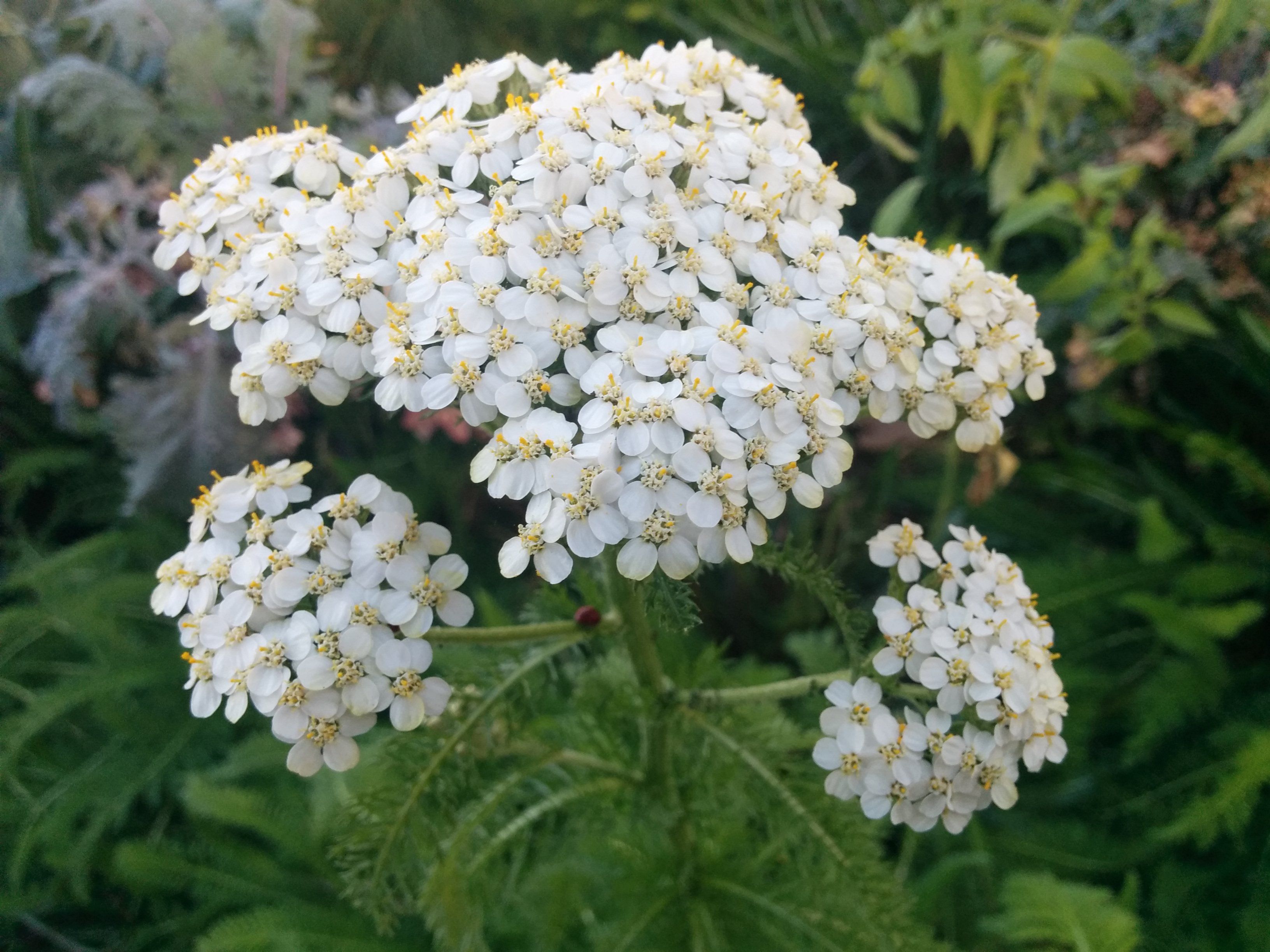
More posts in this series:
Part 1: From Grass to a Vegetable Polyculture
Part 2: How I Used Pioneer Veggies to Build Healthy Soil
Part 3: A Permaculture Consultation for A New Garden
Part 4: Celebration of Abundance! Epic Garden Harvest
Healthy soil is critical for a healthy happy garden!
Just as I discovered in my very 1st suburban garden this back yard had the product of industrial suburbia: industrial grade soil. When the tract homes had been built the top soil was scraped away, the soil was graded and compacted and then grass was added.
The soil didn't have much life at all and as I mentioned in Part 1 of this Garden Tour, the initial veggies that grew from the seeds I planted didn't get much taller than 2 or 3 inches and their leaves got yellow. They were weak and were sitting ducks for slugs, and other pests. It was pretty sad to see all that potential for veggies just blocked by unhealthy soil.
Veggies to the rescue to build healthy soil!
The cornerstone of my plan to growing healthy soil was to get all of the soil covered by vegetation. After sheet mulching the entire backyard, I scattered over 40+ varieties of veggie seeds into the soil and I let nature decide what would grow and where it would grow!
At first I was a little sad because I didn't get tomatoes, eggplants, peppers and other summer veggies growing very well or at all. Nature's way of telling me that the soil in general wasn't ready for those types of plants without further work on my part or on the garden's part or both.
Maybe 1/5 or 1/4 of the type of veggie seeds that I broadcast were growing and thriving. But what plants did grow were so abundant and productive, I learned to appreciate what nature provided and happily incorporated them into my diet regularly in fun and new ways. All of this growth in the garden constantly amazed and delighted me.
Pioneer Veggies to the Rescue!
Now I will share with you some of the "pioneer" veggies that thrived in the soil environment that was freshly sheet mulched, had limited life and sub-par quality industrial compost. If these veggies can thrive in this condition maybe they would be helpful in building soil in your own garden.
Daikon Radish
This radish can get HUGE! It grows fast and powers its huge tap root down into the soil. In this picture you can see it grew down through the sheet mulching, hit the clay soil and thrust so hard it pushed itself up out of the soil. But that didn't stop it from growing down through the clay soil below.
Daikon if left in the ground will eventually rot and create space between compacted soils, rotting and creating habitat and food for worms, roots and other soil life. It is great at building organic matter in soil. The leaves are robust and vigorous and create good shade cover for the soil.
Daikon radish is delicious pickled, shaved in salads or in stir fries or curries. The greens are also edible and while not very palatable raw they are good in stir fries and stews. @idyllwild even made a roasted daikon salad dressing that was to die for!
Radishes
While Daikon is known for it's deep taproots other radishes perform just as well in less than perfect soils. Whether you are a radish fan or not it's a great plant for building soil. If you are a radish fan, try growing different kinds for some variety! Here is a huge black radish.
When it gets hot radish flowers put on a stunning display of fireworks.
Turnips
Turnips don't grow deep like Daikon radishes but they also grow a decent amount of foliage that help shade the soil and eventually drop to the soil to mulch, rot and break down into rich top soil.
Turnips have a very unique taste. I enjoy them in stews and stir fries. You can't go wrong cubing them and sauteeing with onions in some butter and white wine ;)
Fennel
I would have never guessed that Fennel would thrive so well in my garden. They sprouted and reseeded so easily and I had a nearly unlimited supply of Fennel and Fennel seeds for my kitchen!
From an aesthetic perspective Fennel brings a very soft texture to the garden like green flowing fountains. They are fun to touch, run your hands over and smell the strong Anise fragrance as you walk through the garden. Fennel is so appealing to many of my senses.
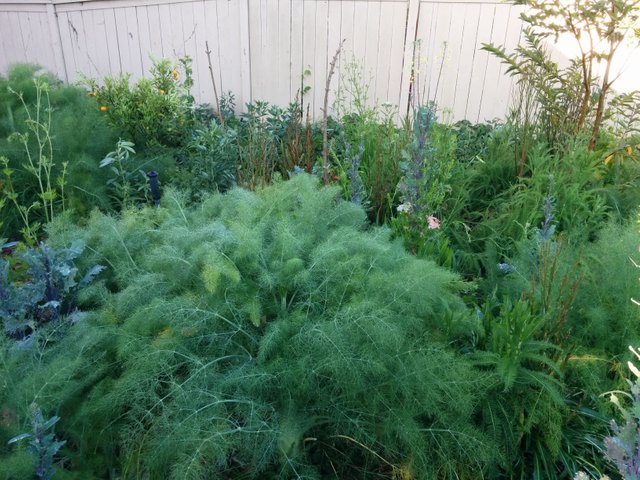
At times I was busy thinning the vigorously reseeding Fennel plants so that their stems would grow thick and juicy. But I also let some go wild and do whatever they wanted.
Fennel flowers also put on a stunning display and shoot up high above the other garden veggies with a beautiful radiant yellow. After going to seed the Fennel seeds hang on the plant for a long time making harvest easy.
Kale
Red Russian and Lacinto Kale dotted my garden. Having Kale leaves available anytime for harvest is extremely rewarding. Since I threw out a bunch of Kale seeds I ended up with dozens of plants. So I would go out and take a few leaves here and there from different plants and in a few minutes I have armfuls.
Some of the Kale plants leaves did not look as vibrant as others. But no matter, because they were all doing their part to shade the soil, drop leaves and build more mulch and organic matter on the soil. It is also interesting to see the Kale plants in one place look amazing and then somewhat drab in another spot. I began to learn to watch the leaves of Kale and other plants as indicators of the soil health.
Collard Greens
The tough leaves on Collard Greens plants are very robust. Some of the leaves get so huge that one leave can be used for a modest meal!
The leaves are great in chili or sauteed southern style in some vinegar, salt and a little sugar. And bacon if you are so inclined ;)
Lettuce
I was surprised to find out that lettuce did so well in this new soil. I seeded several types of lettuce and to one degree or another they all did alright, grew vigorously and reseeded with more lettuce plants growing all the time.
So much lettuce grew that I didn't even think about trying to use it all. But no matter because the leaves made excellent mulch and organic matter for the soil.
I found it difficult to keep the lettuce leaves sweet year round. But in the spring they are delicious raw. I actually like some bitter lettuce leaves mixed in with other greens in my salad as long as the bitter flavor doesn't dominate the dish. I also found that lettuce leaves are great cooked into pastas, soups, curries or stir fries where the bitter flavor disappears.
Chicory
Chicory was one of my favorite living mulch plants in this suburban garden! It is a relative of Dandelion so it is no wonder it is so robust in many soil and weather conditions. I was clearly giving it more than ideal soil and water conditions because it grew like CRAZY.
The swath of Chicory below the Fennel in this photo is a testament to how several Chicory plants can create a robust living mulching system, bringing up nutrients from the clay soil below the sheet mulching with their deep roots, growing leaves which can be eaten or dropped as mulch below. With the thick layer of leaves the soil below is always cooler and moister than surrounding areas that have thinner vegetative cover.
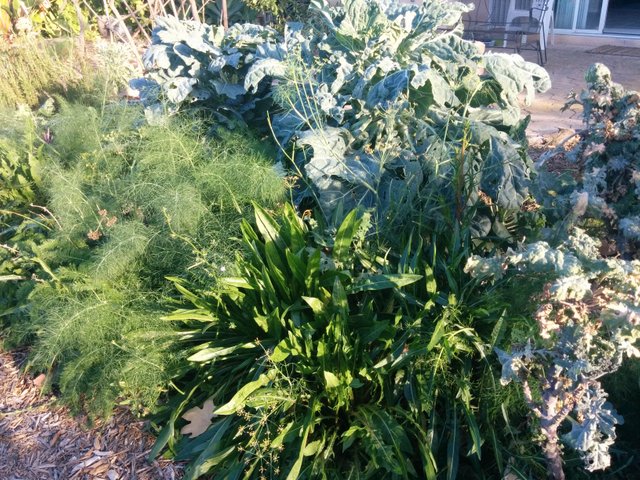
Here you can see the Chicory in a drier hotter area. It's leaves are skinnier and less robust but it is still doing a great job of creating mulch and covering the area directly below it. This Chicory is getting ready to bolt.
Unlike Dandelion which has a single flower per stem, Chicory sends up a huge branching multi-stemmed flower stalk with brilliant blue flowers! If you asked @idyllwild what this plant is when it is in bloom, she would tell you it is a wild version of Bachelor Buttons.
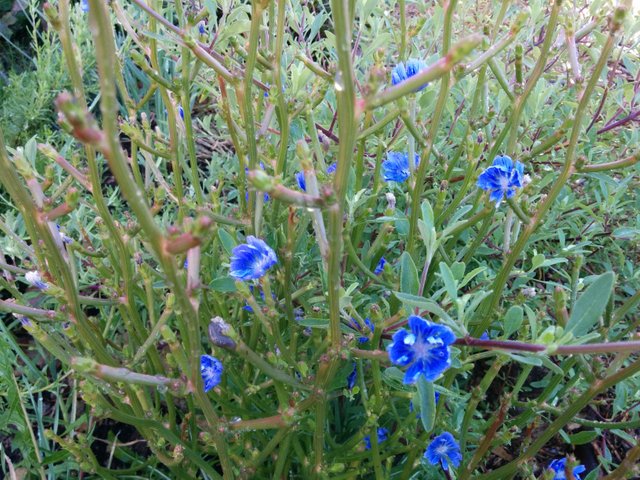
Chicory leaves are very similar to Dandelion leaves. They can be bitter so sparsely added to salads or cooked into eggs, stir fries, stews or curries are good ways to include Chicory leaves in your diet. Like Dandelions, they are highly nutritious!
Yarrow
Yarrow is another fantastic living mulch plant! Its leaves are slightly reminiscent of ferns but they are very soft and flowing. Like Fennel they bring a whole new visual texture to the garden. They don't get very tall so they can be an under story to taller plants. You can see the yarrow on the left and right side of this photo covering the soil very nicely.
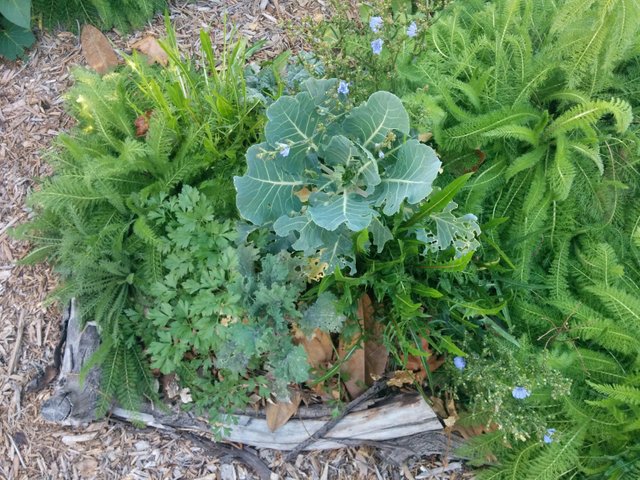
Yarrow tap roots can be pretty strong so be somewhat cognizant of planting it where it won't need to be dug up too often. For that very same reason yarrow is hardy even in drier conditions. With less water Yarrow leaves won't be quite as big and robust but they are still quite healthy and happy.
Check out the yarrow serving aesthetically and functionally as living mulch in the lower right and upper right patches of this photo. Each clump is many yarrow plants growing together. The yarrow seeds are extremely tiny and difficult to separate. I obviously sprinkled many seeds in a small space... how exciting that so many of them sprouted in these soil conditions!
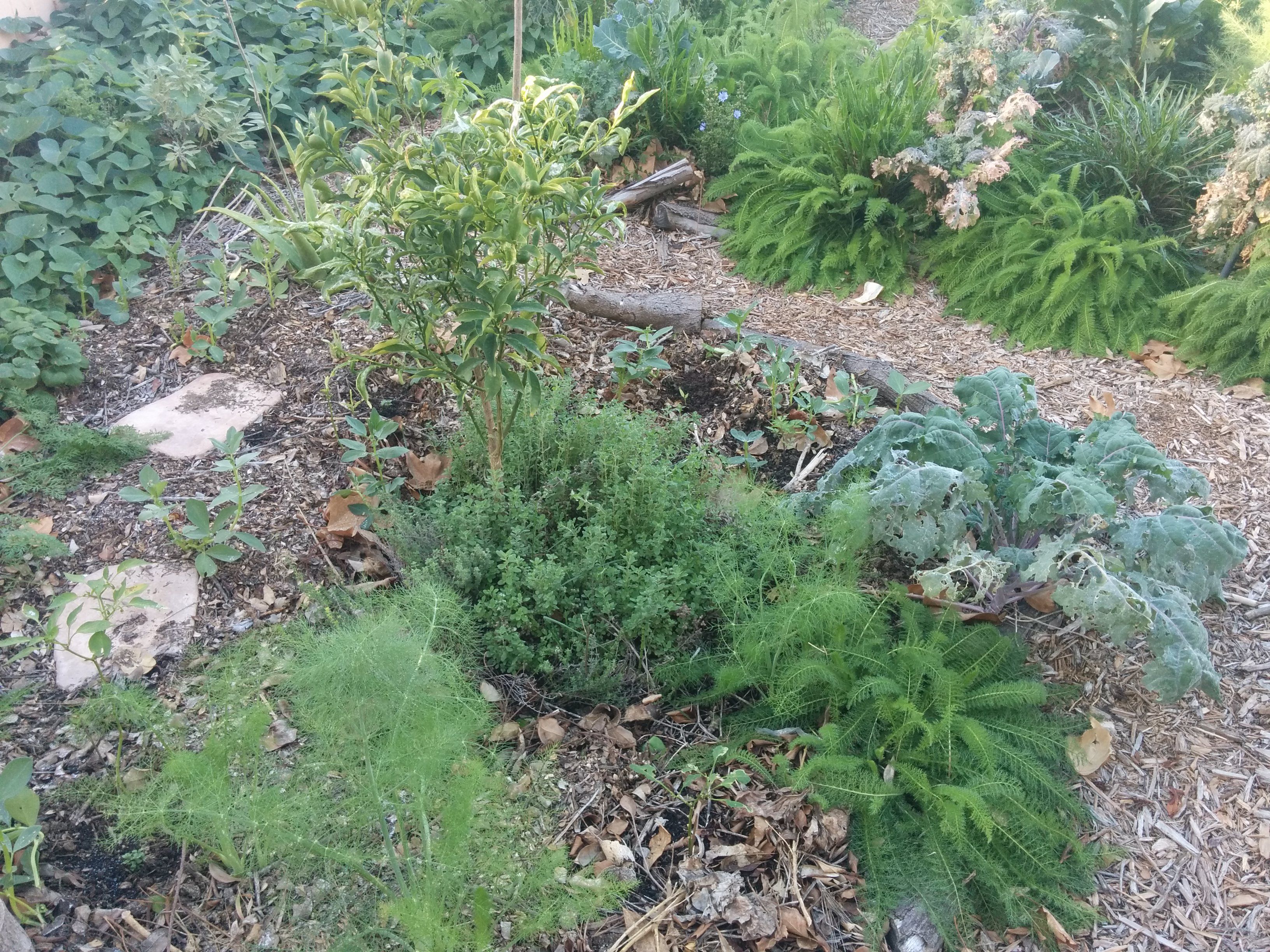
Yarrow flowers are quite beautiful. @idyllwild loves to dry yarrow flowers for her dried wreath arrangements. They are nice in bouquets or just left in the garden as well.

While Yarrow is not a veggie it is renowned for its healing qualities. Yarrow is known to help stop bleeding and heal external wounds. It can also help heal internal wounds. It has many other amazing qualities and I recommend looking into it as a first aid plant you can grow in your garden or if it grows wild in your region... ditch the Neosporin!
Chard
I love chard leaves for salads and stir fries! The huge leaves make amazing wraps.
Chard plants did not germinate quite as well as I had hoped in my initial garden seeding. However I did get a few plants and kept them happy with compost and mulch. After one season had passed I tried another seeding of chard.. apparently the garden soil had evolved because this time I had many more Chard coming up. This time I tried a variety called Perpetual Spinach. It is a milder tasting chard and does resemble spinach somewhat closely with a very buttery flavor! I did really enjoy eating this chard and it seemed to thrive in the shade of other taller plants.
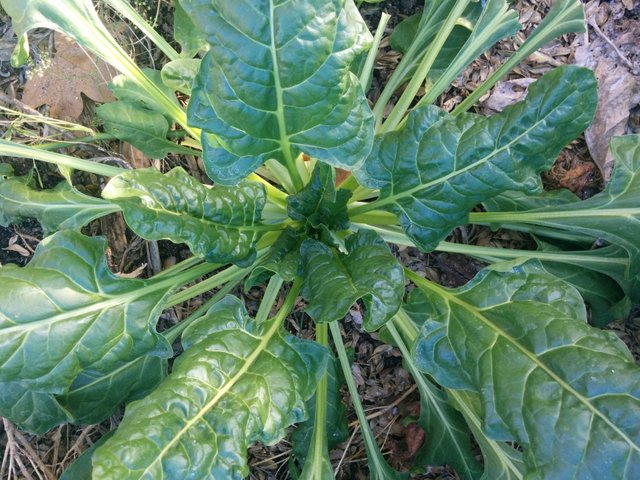
These Chards are about to flower. Chard reseeds very vigorously and the seeds are really easy to collect.
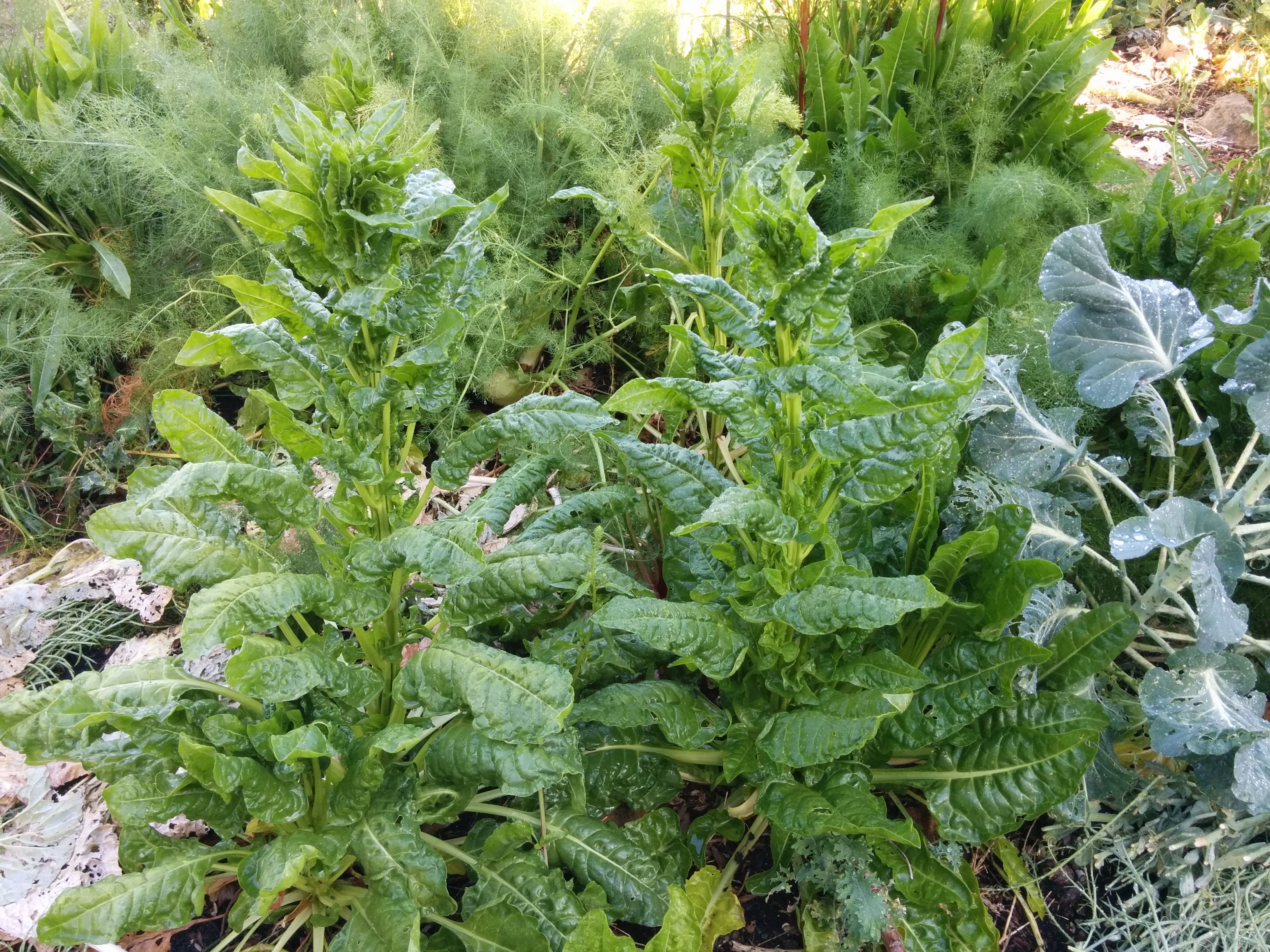
Parsley
Parsley is one of my favorite Permaculture herbs! It takes a little time to get established in the garden but once it does it does not fail to amaze me. It comes back year after year and reseeds itself easily.
I had several parsely plants going in my garden and while one was reseeding and didn't have many leaves another one in a shadier spot or one that was younger and didn't start to flower yet have many leaves! I had fresh parsley leaves throughout the entire season with literally no extra effort after the initial scattering of seeds!
Other Herbs
Herbs like Oregano, thyme, savory, marjoram, sage and others are quite wonderful in the garden. Many herbs tend to spread whether by layering or by reseeding or both. Some herbs like mint spread by rhizomes. I love the fact that many herbs can help with covering the ground and they a lot of them tend to do it well when combined or nestled with other plants!
There is nothing like having more fresh herbs in your garden than you could possibly eat. One packet of seeds and never again will you pay 5+ dollars at the supermarket for a tiny bunch of herbs. Free herbs any time you want it and you can dry them and have free herbs year round! How amazing is that! Herbs for stews, chili, pasta sauce, tea, soup, stir fries, you name it.
Here are some oregano and thyme on the edge of a garden bed. They started as one plant that expanded. Then I separated out the roots and replanted them 6 or 8 inches apart. After some more time they filled in the whole area!
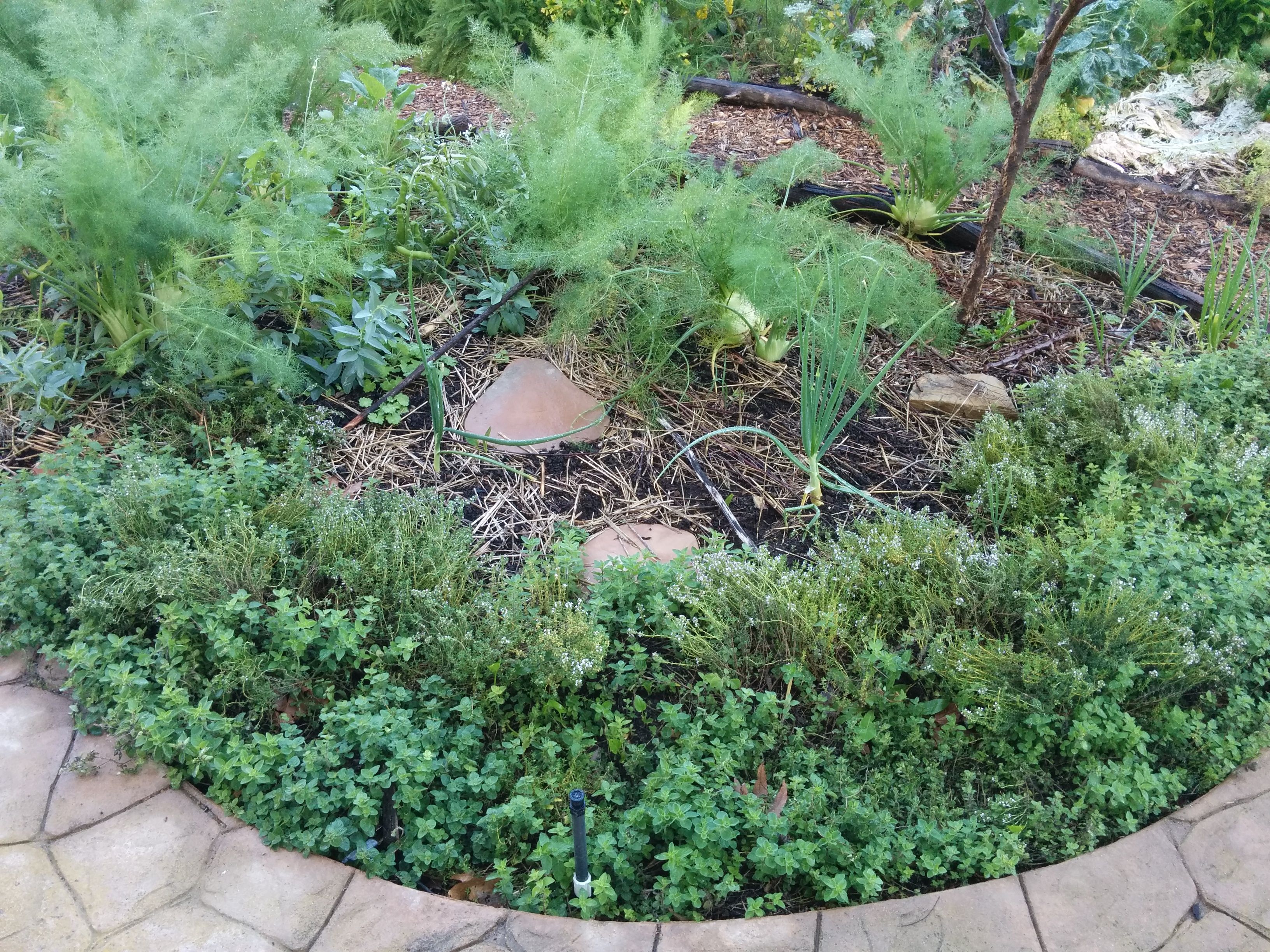
Fava Beans
Oh Fava beans! Maybe they should be at the top of the list. Fava beans are such a wondrous cover crop and companion plant! They can grow well together or with other plants. They do like company of other plants so that they can be propped up. But if there is no plant next to them they will bend over and grow along the ground for a while and then shoot back up again.
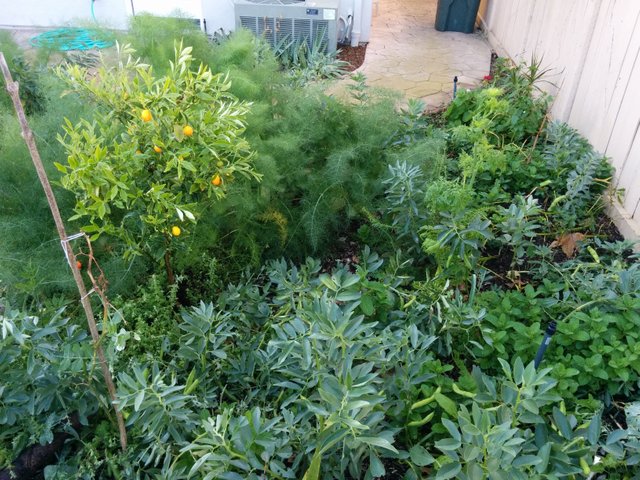
Fava beans are vigorous producers in many soil conditions. They create huge beans which can be shelled and cooked for adding substantial amount of protein to your meals. Interestingly their leaves are also edible raw or cooked. They make tasty salad greens as their flavor is mild and a little buttery and a little nutty.. somewhat similar to spinach.
Fava beans are in the legume family so they are nitrogen fixers and help harness nitrogen from the atmosphere and put them into the soil. Chop and dropping fava beans 1/2 or 2/3 down the plant when they are in the flowering stage will help release that nitrogen into the soil and they will continue growing and branch from where you cut them. If you don't chop and drop, no worries the nitrogen will end up in the leaves and beans and whatever you don't harvest will drop to the soil and become soil food!
Fava bean pods are easy to collect. Be sure to set some aside for planting in the next season or as succession crops. But you can also let some dry and fall to the ground to replant themselves! Check out the huge pods on these fava plants!
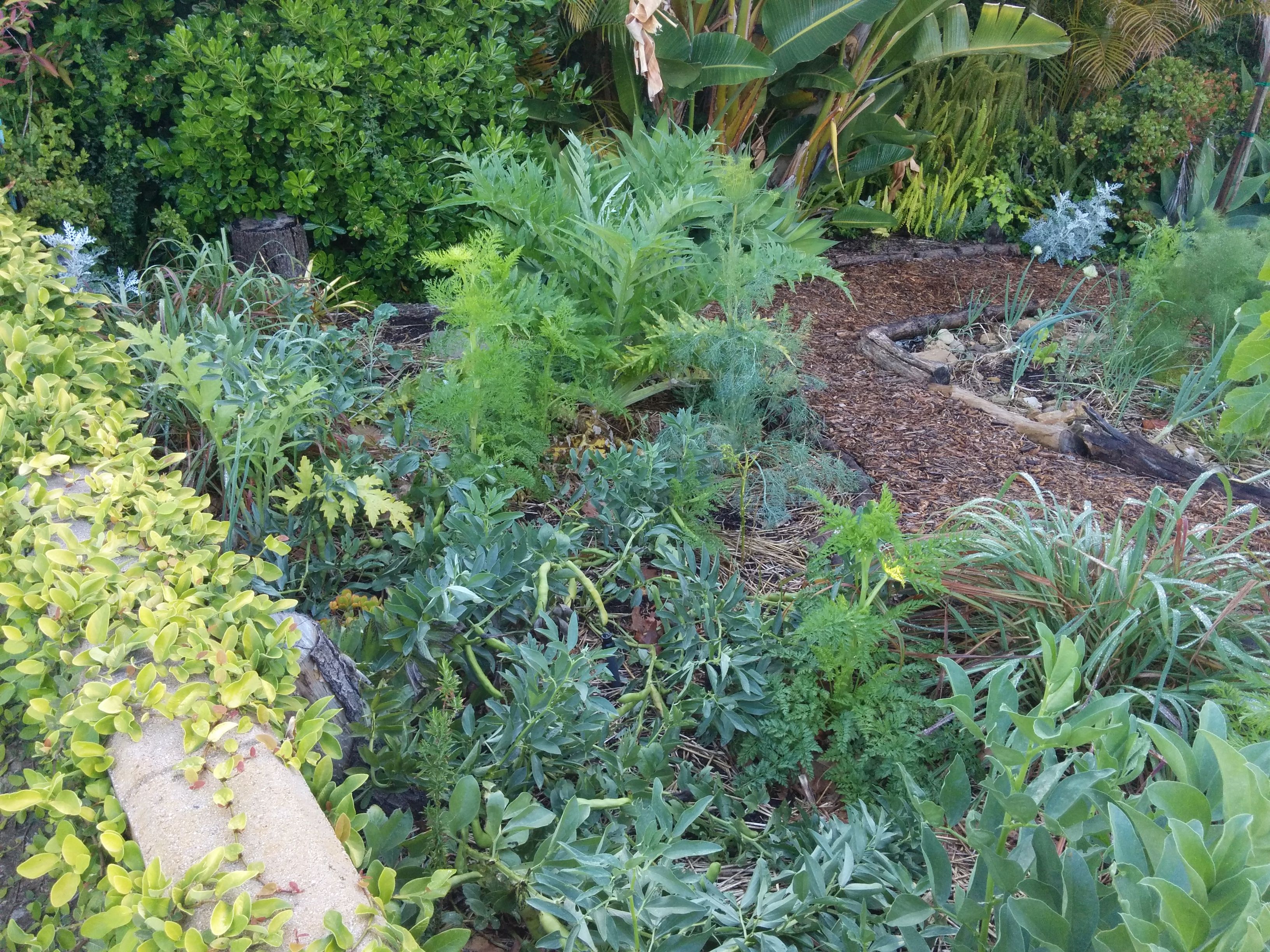
It is a treat to see the string of flowers growing up a fava plant where the pods will appear. Shortly after the flowers bloom, look closely and you will see a little bean pod! Before long it will be huge!
Carrots
Carrots belong in every garden! They are so easy to grow and you can seed them pretty much any month of the year. In colder climates you can mulch them and store them right in the soil and harvest throughout the winter!
Carrots are biennials so they won't go to seed in their first year. So I like to leave some carrots in my garden so that they will go to seed the second year. Here is a second year carrot that has just become so massive!
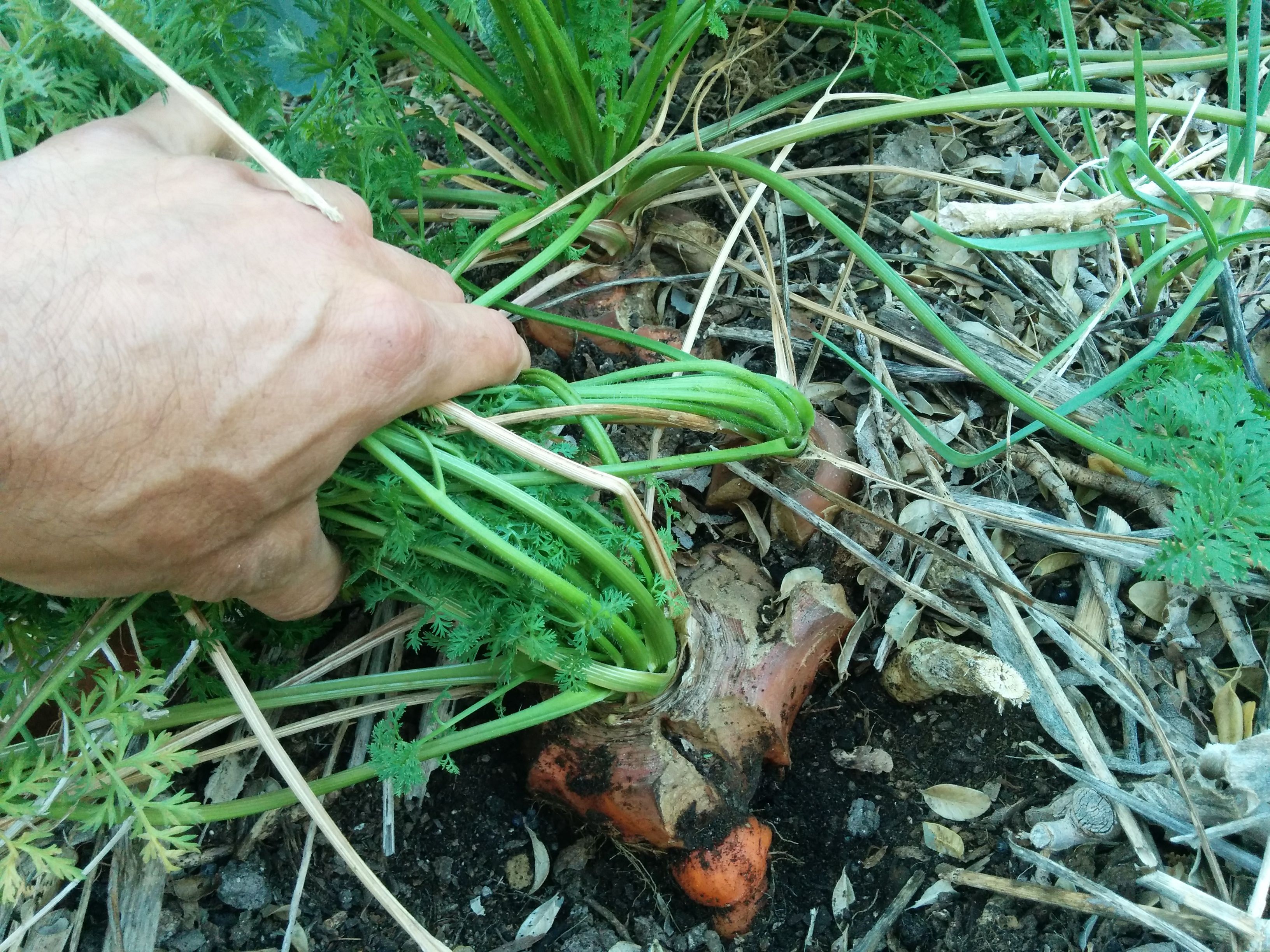
And here's an old 1st+ year carrot... WOW!
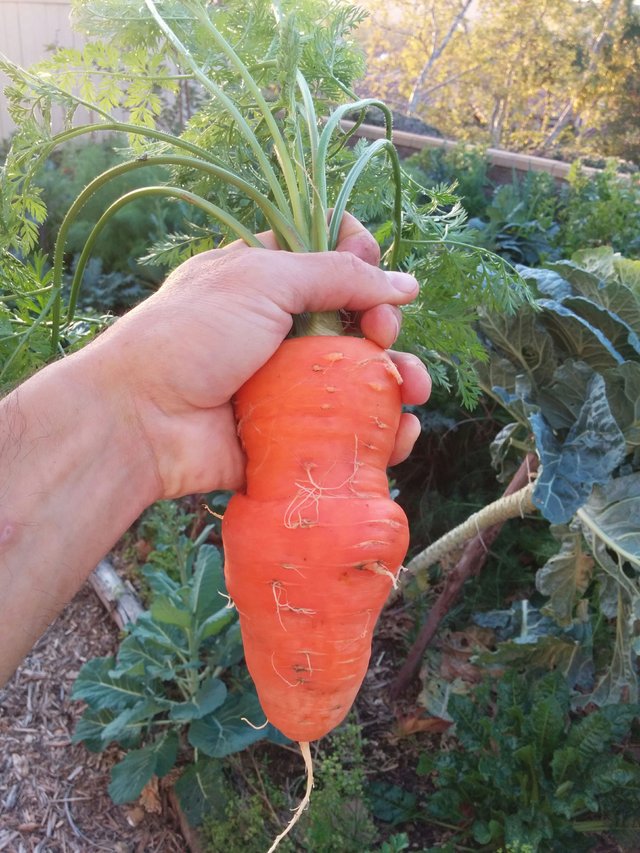
Like daikons, chickory, dandelion and other deep rooted and tap root plants, carrots can help break up compacted soil and left in the soil to rot would help create organic matter in the soil and habitat for worms, insects, microbes and food for other plant roots.
One interesting thing about carrots is how drought tolerant they are. There was an area of my garden that was neglected and seldom watered. I wasn't paying much attention to it because not much was growing yet. But I had a few carrots growing there. I didn't pay much attention to them either because they were so small and didn't seem to be growing much. Well they didn't grow too much more, but without much water they still hung on right through the summer until I was digging around and dug up a few small carrots and my mind was just blown! How they could hold on that long without water was a miracle of nature!
Potatoes
The potatoes and sweet potatoes that I planted in the garden were growing so vigorously! I later learned that potatoes do well with new garden soil. They may not produce as well as a mature garden soil, but if you mix in a little compost or manure and plant your potatoes, they will produce! They are a great crop to plant a lot of in a new garden which will help build your soil.
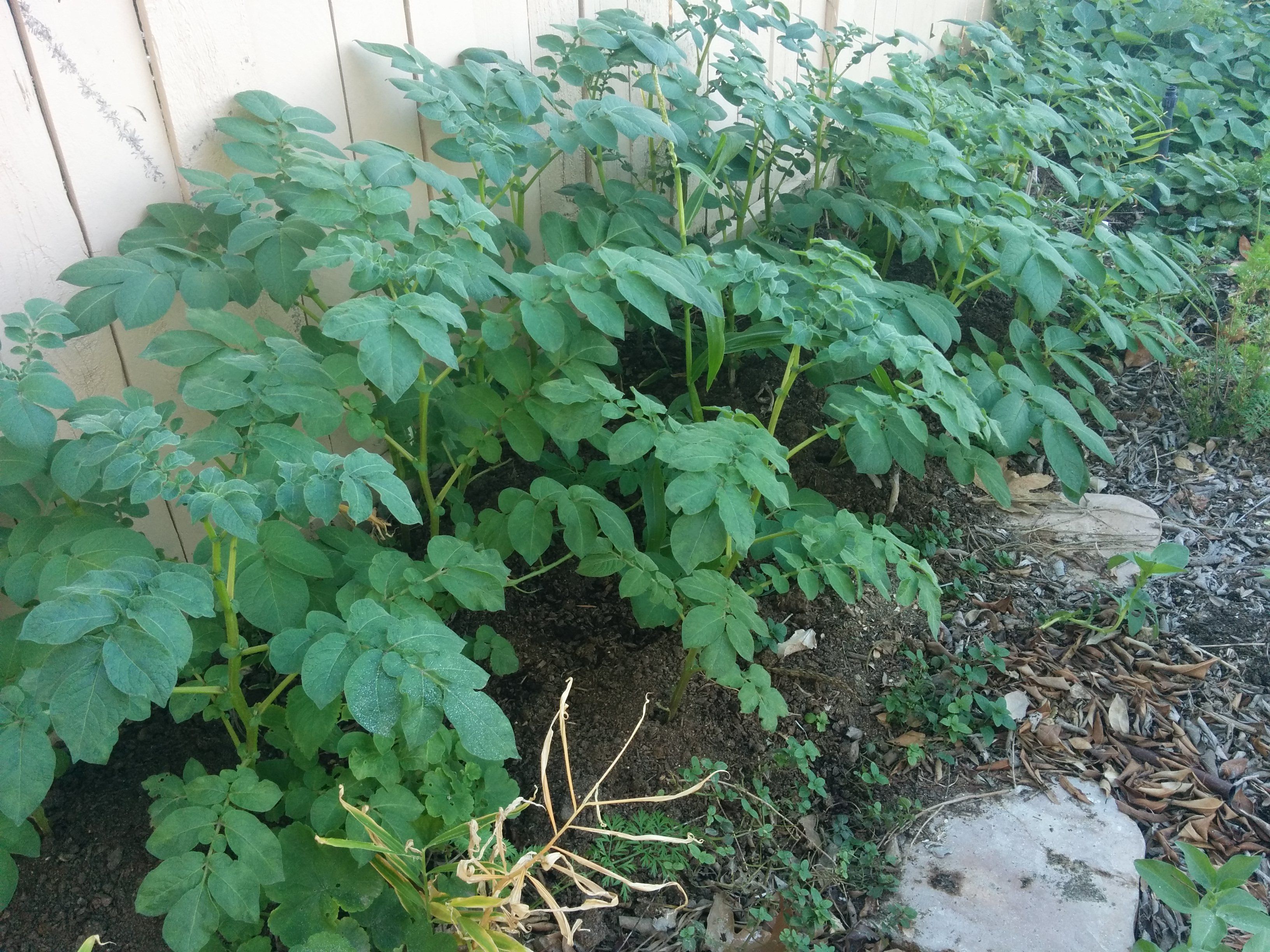
I moved out before I had a chance to harvest my potato crop, but I did check in on them from time to time. I did end up enjoying a few small fingerling sweet potatoes :)
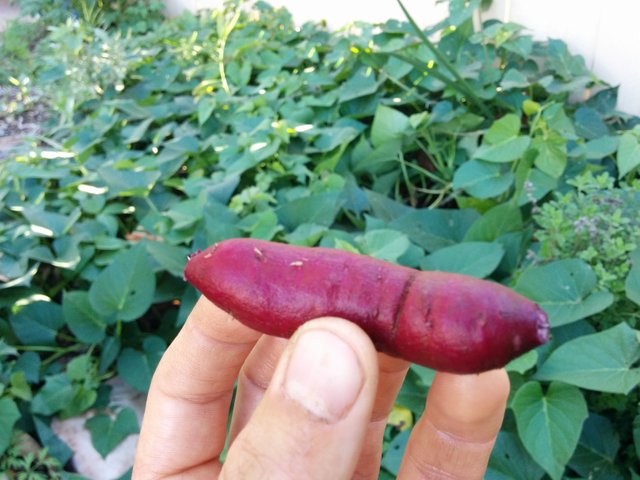
Onions
I actually didn't directly seed any onions in my garden. But as I ate my store bought onions, I cut off the bottom part with the roots and stuck them into the soil. Then they grow a new onion plant! Since I eat a lot of onions, after a few months I had a lot of onions growing in my garden!
Onions are great because the leaves are so skinny so they don't compete very much for space and light with plants around them. They can easily be squeezed into small spaces here and there until harvest time. I also enjoy cutting off some of the big green leaves and slicing them for stir fries or raw on salads or potatoes.
Onions do also reseed very easily and their flowers are a sight to behold!
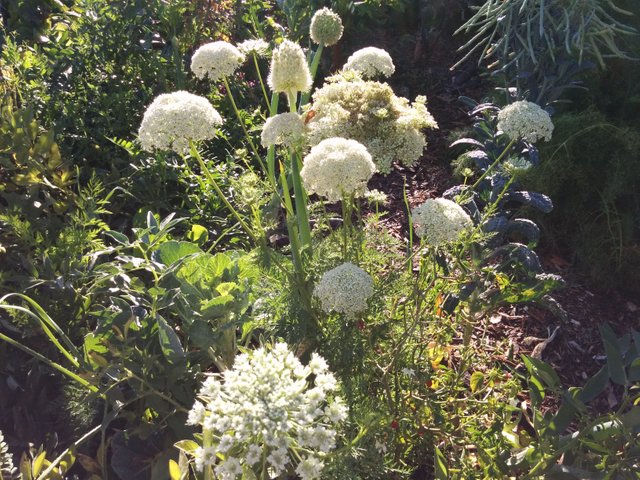
This one is just about to open!
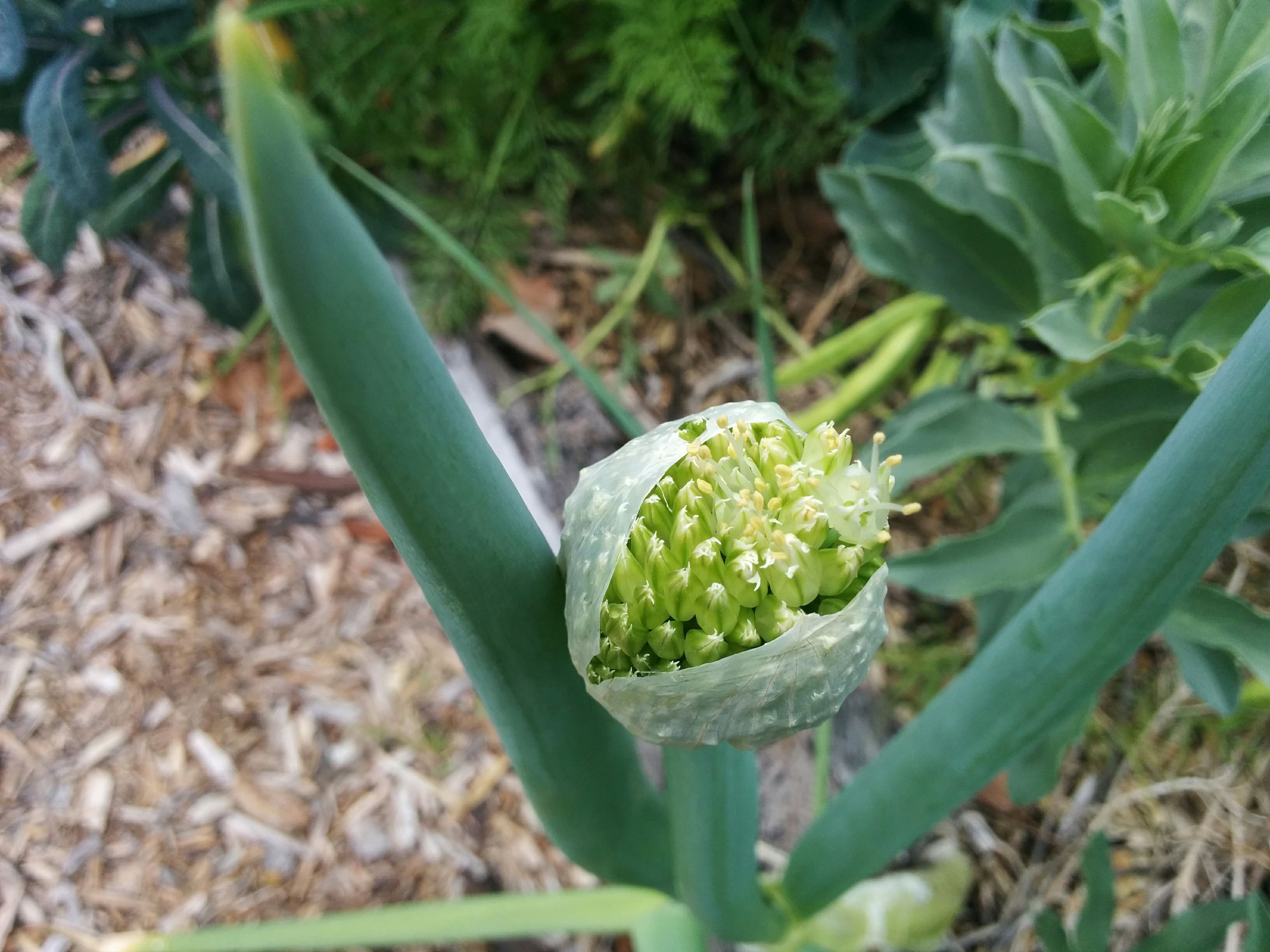
Mustards
Mustards, including Bok Choy do very well in less than ideal soil conditions. With Bok Choy however, it seems to like cooler weather. When it starts to warm up it goes to flower. Other mustards can handle warm weather better but I love the flavor of Bok Choy!
Here are some mustard flowers. The yellow color adds a fun contrast to the garden in the summertime.
Depending on the variety of mustard you grow you can collect the seed pods and then coax the seeds out of them to use as a mustard spice in the kitchen. Grow a few plants and you could collect a years worth of mustard seeds, depending on how much you use! You could also easily make a prepared mustard with some vinegar and spices.. yum! Say goodbye to store bought mustard and mustard seeds!
Broccoli
Broccoli grew very well in my garden's early soil conditions. Well the leaves grew very well! The broccoli heads formed pretty well, but the next year they were even better.
I like broccoli plants because similar to collard greens they offer prolific leaves that are quite large. The leaves and stems are also edible and provide a fantastic mulch when they drop to the ground!
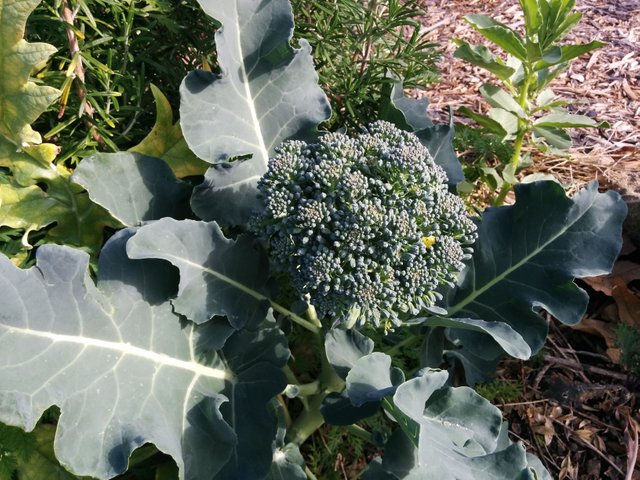
Artichoke and Lemongrass
Both Artichoke and Lemongrass are more specific to warmer climates, but I am going to mention them here just because of how amazingly well they grew, thrived, multiplied and produced in this young garden!
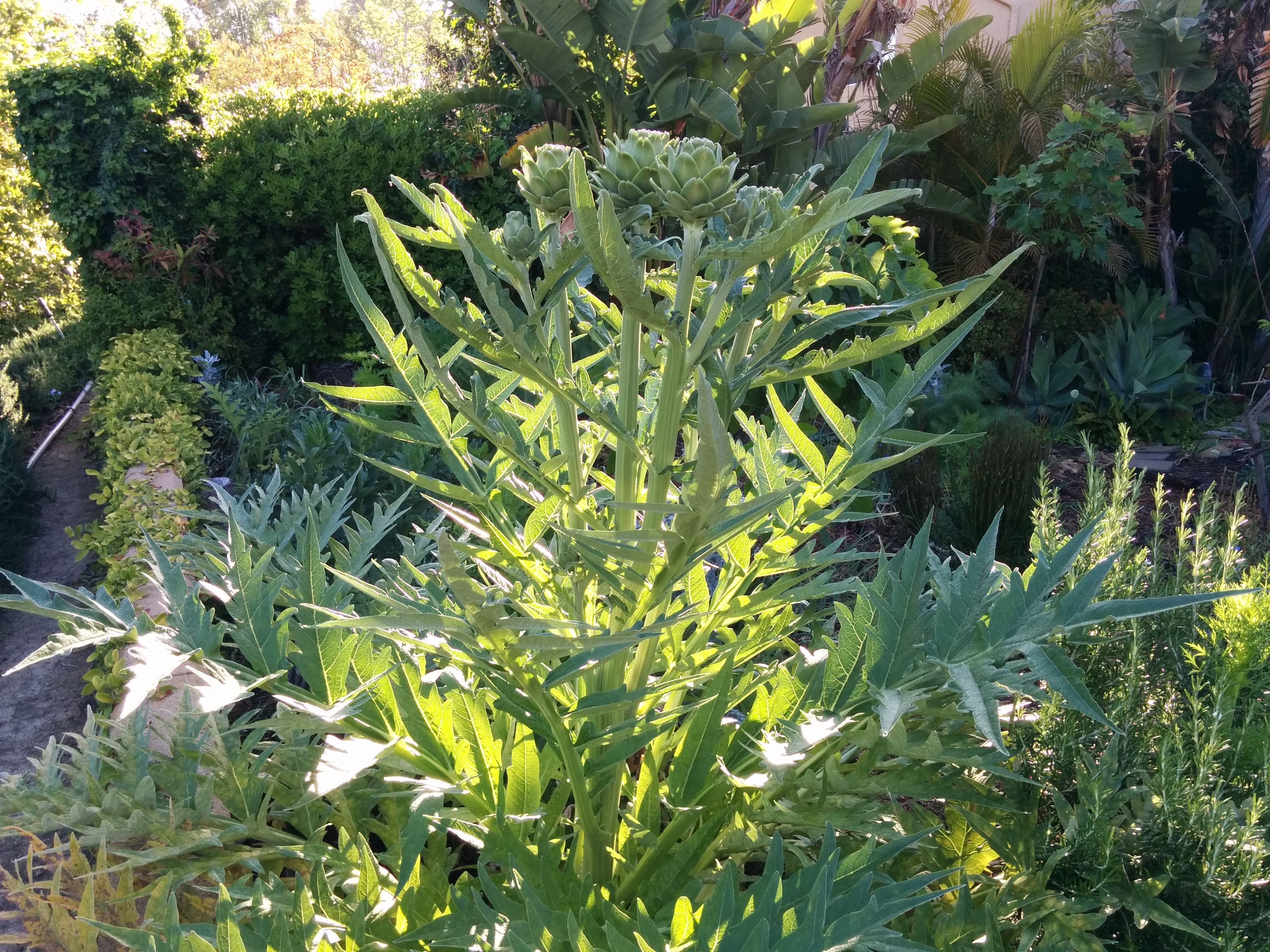
I put them in the hottest driest part of the garden and they did not fail to thrive.
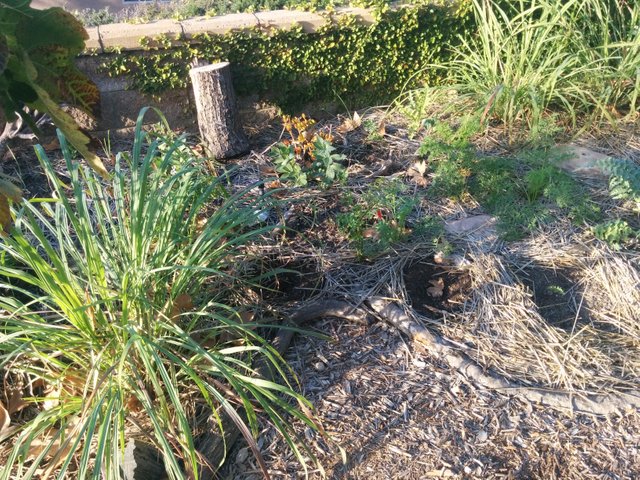
Some lessons I learned from this new garden
When I started seeding this garden I wildly scattered seeds of all kinds of veggies over my newly sheet mulched soil. I had just finished reading Gaia's Garden by Toby Hemenway and I was sold on the idea of using cover crops to help build soil. Traditionally cover crops were used for animal fodder or for turning into the soil to increase the organic matter.
I thought what if I used vegetables as my cover crops so that I can eat some of them while building soil at the same time? I am really glad I asked that question because it helped me change my mindset about harvesting. Previously I tried as hard as I could to harvest every last leaf, fruit, stem and bean that was produced in my garden. With this new approach I was OK with not harvesting everything because those plant matter that didn't get harvested either stayed alive and continued to shade the soil or died and dropped to the ground and became food for the soil, plants, worms, microbes and more. I had plenty to share with friends and family and plenty more to go back to the earth, just like Mother Nature intended.
Shortly after moving from this home I read One Straw Revolution by Masanobu Fukuoaka. I highly recommend it to any gardener or homesteader. I learned Fukuoka's trials, experiments and successes growing rice, other grains and veggies by letting go to nature instead of trying to control it. He called it Natural Farming. In a nutshell He basically seed bombed his fields and gardens and let nature decide when the seeds should grow. His style of farming really resonated with me and it has influenced me a lot since then. I realized that this garden was starting to teach me some of those lessons. After reading One Straw Revolution it took my understanding to another level.
In the first spring seeding most of the veggies I listed above thrived! The garden really wanted to grow greens, roots and herbs.
Things like corn, squash, tomatoes, peppers, eggplants, some beans are all much more picky about the soil conditions. They needed more symbiosis, microorganisms and rich soil life. They did not grow very well at all, if at all. However going into the second year I planted more of these plants and they did significantly better. After many rounds of mulching, compost tea, compost, wood ash and other organic matter added to the soil as well as decomposition of organic matter and worms, insects and microbes coming to life the soil was starting to support a wider variety of plants, including these pickier plants. There was still room for improvement in these plants health and fruit production, but it was really amazing to see the evolution of what I could grow in just one year. It would just keep getting better and better.
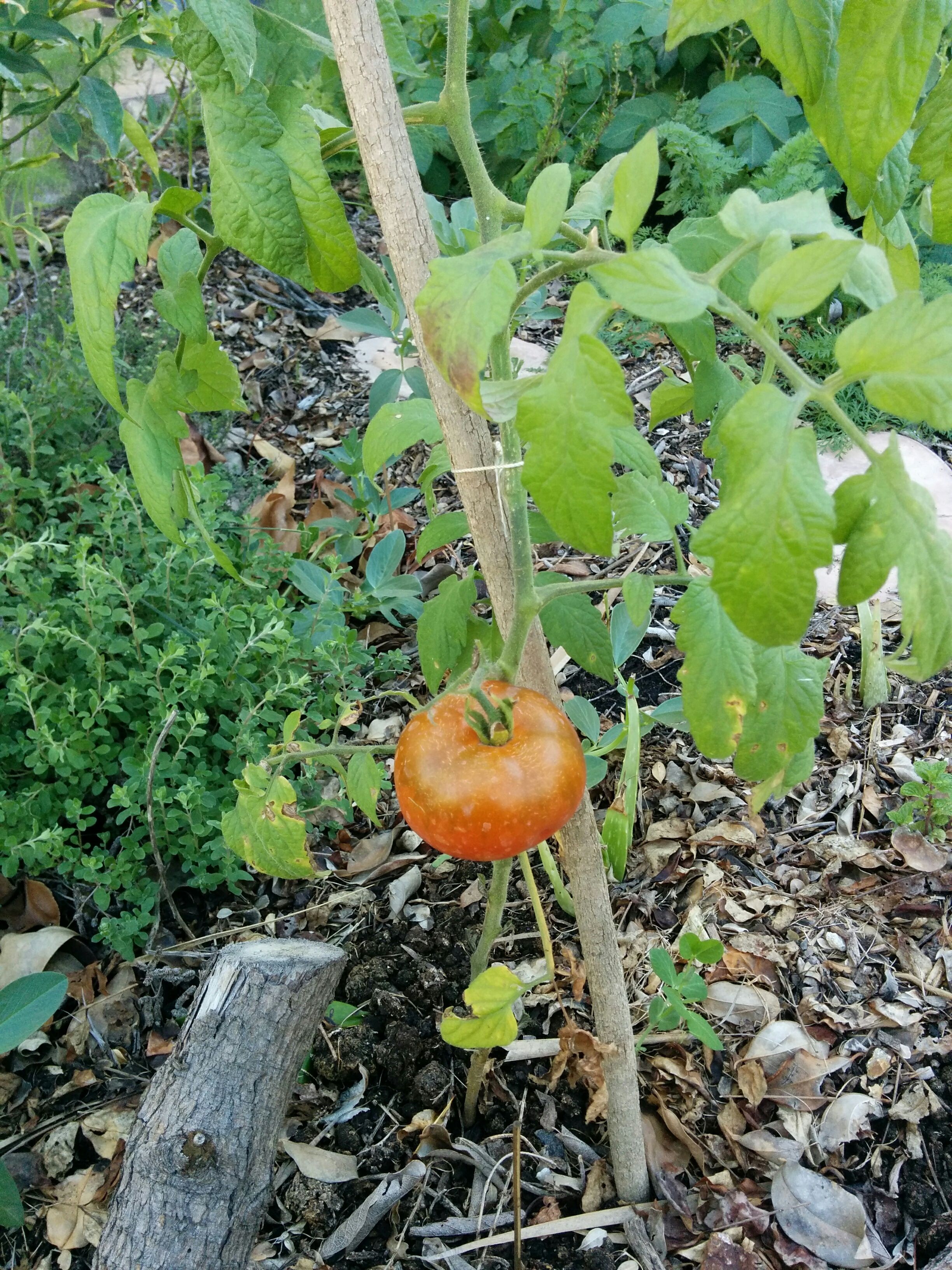
These are the first tomato and corn that I grew in this garden. They are not the prettiest ones I've ever seen but they marked a major improvement in the soil and I was so excited to harvest them!
How did I know that my soil life had microbes in it? I put it under a microscope, thanks to my Permaculture instructor and lessons in interpreting soil life in slides from Elaine Ingham. I compared the soil in different parts of my garden with abundant plant life, soil with little to no plant life and the compost and vermicompost that I was making and adding to the garden. The compost and vermicompost had a huge amount of microbes, fungi and other beneficial life. It helped give me confidence that the compost tea that I was making would multiply and deliver these beneficial organisms to the soil.
In general, this garden gave me so much joy. My inspiration for the design was nature. I loved hiking and camping so the pathways meandering through the garden symbolized to me a walk through nature. I even added a fire pit on the patio that I scavenged from Craigslist so that I could enjoy campfires in my backyard. This garden helped me get closer to nature every day that I tended it and relaxed with it.
Let's go! Join me here for the 2nd part of this suburban garden tour :)
More posts in this series:
Part 1: From Grass to a Vegetable Polyculture
Part 2: How I Used Pioneer Veggies to Build Healthy Soil
Part 3: A Permaculture Consultation for A New Garden
Part 4: Celebration of Abundance! Epic Garden Harvest
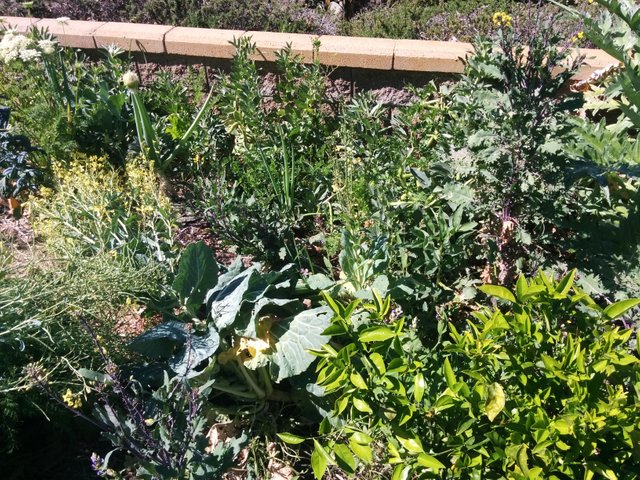
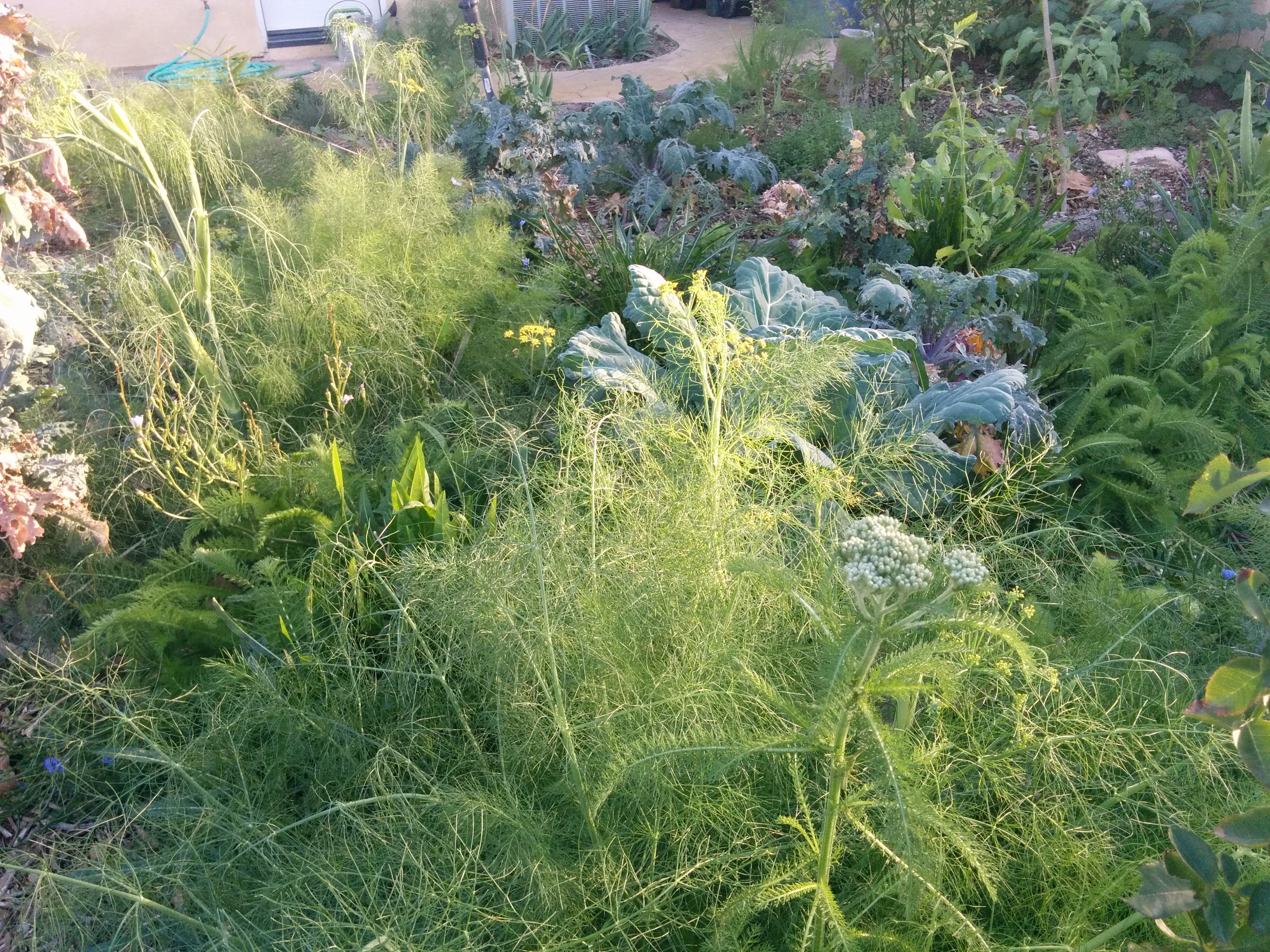
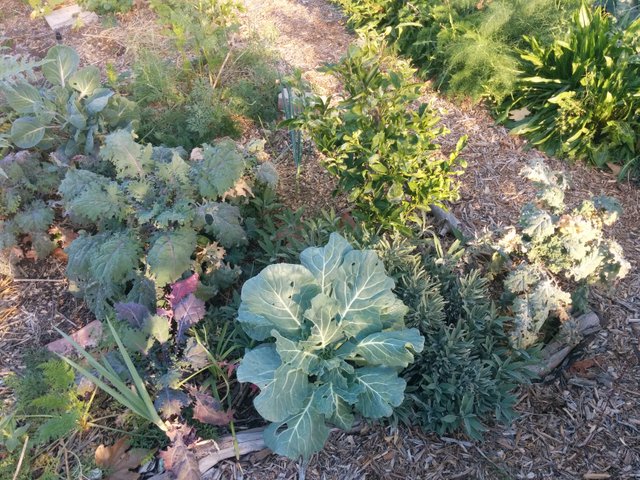
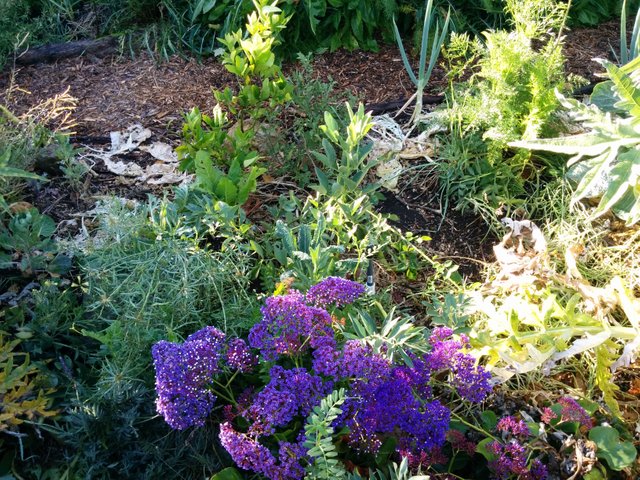
You wanna bet!? LOL! As soon as the heatwaves hit we go around grabbing all the carrots that have started to go to seed before they get too woody! Some years our parsley goes to seed in the first year too. Things don't seem to grow as they should here!
Downvoting a post can decrease pending rewards and make it less visible. Common reasons:
Submit
Haha ok no I don't want to bet, I believe you :) I haven't seen that but it sure makes sense, there are always exceptions to the rule even in nature. That's pretty cool that you get seeds earlier, you're selection for carrots can be 2x as fast!
Downvoting a post can decrease pending rewards and make it less visible. Common reasons:
Submit
That's a good point. Look at the positive!
Downvoting a post can decrease pending rewards and make it less visible. Common reasons:
Submit
Everything in the carrot family has been going nuts rhe last few years in our area
Downvoting a post can decrease pending rewards and make it less visible. Common reasons:
Submit
I bought what I had thought was dill but turned out to be Fennel and had no idea what to do with it
Downvoting a post can decrease pending rewards and make it less visible. Common reasons:
Submit
I lalalalove fennel. I had no idea what I would do with it until I saw a British cooking show and the lady did three different dishes with it that looked ah-mazing, and I’ve grown it since then. None of my food looks like hers (I feel lucky if anything I cook looks like food at all) but fennel sure is tasty!
Downvoting a post can decrease pending rewards and make it less visible. Common reasons:
Submit
Cool!! What is your favorite dish to cook with fennel?
Downvoting a post can decrease pending rewards and make it less visible. Common reasons:
Submit
I guess I’d call it Fennel Chicken.
Brown a couple pounds of chicken, that you’ve salted, peppered and dusted with about 2 TB of flour, in some olive oil in a heavy pot or dutch oven. Once it’s good and brown, remove it and saute a couple cloves of minced garlic. Add a sliced red onion, a medium sized fennel bulb sliced real thin and a bay leaf to the pot. Pour in a cup of chicken broth, the original recipe calls for white wine of some sort, but I use chicken broth. Return the chicken to the pot and partially cover it with a lid and braise over low heat for about 20 min, and then check on it. If there’s still quite a bit of liquid, let it go another 10-15 minutes, until the liquid has turned into a sauce. In a bowl, mix 2 TB of creme fraiche and a little of the braising liquid to temper the creme fraiche, the stir it into what you’ve got going in the pot. Serve it up with a little chopped fennel leaf.
To make creme fraiche, combine a cup of whipping cream and 2 TB of buttermilk in a glass container and leave it to set at room temperature for 8-24 hours, or until it’s very thick. Stir it real good before you put a lid on it. Keep it in the fridge for a week or so.
Downvoting a post can decrease pending rewards and make it less visible. Common reasons:
Submit
That sounds so delicious!! I must try this next time I get my hands on some fennel and cream :) I am drooling thinking about what the sauce must taste like!
Downvoting a post can decrease pending rewards and make it less visible. Common reasons:
Submit
I wonder if I can hack into the frozen ground and dig up one of those fennel bulbs that didn’t get eaten last year...... lol It’s sounding pretty good to me right now too.
Downvoting a post can decrease pending rewards and make it less visible. Common reasons:
Submit
What an adventure!
Downvoting a post can decrease pending rewards and make it less visible. Common reasons:
Submit
Fennel seed is used a lot in indian curries... maybe look into that :) I've also made pesto with the fennel leaves and young stems. Some people don't like the anise flavor very much but if you do, you'd be in heaven!
Downvoting a post can decrease pending rewards and make it less visible. Common reasons:
Submit
Such a vibrant and beautiful garden! Thanks for this awesome and informative post.
Downvoting a post can decrease pending rewards and make it less visible. Common reasons:
Submit
We need the freshest greenest veggies! Thanks for sharing this insight @sagescrub!!
Downvoting a post can decrease pending rewards and make it less visible. Common reasons:
Submit
Totally! More veggies and more gardens!
Downvoting a post can decrease pending rewards and make it less visible. Common reasons:
Submit
Wow amigo gracias por la información,estaré al pendiente de tus post :D
Downvoting a post can decrease pending rewards and make it less visible. Common reasons:
Submit
De nada ;)
Downvoting a post can decrease pending rewards and make it less visible. Common reasons:
Submit
Well that's an amazing garden @sagescrub! Interesting how some plants will push themselves right out of the grounds while others may pull all sorts of nutrients out of the clay.
I guess I hadn't realized you could bring the soil back to health by just growing the right things!
Thanks for that hard work
Downvoting a post can decrease pending rewards and make it less visible. Common reasons:
Submit
Thanks @senorcoconut! Yeah it is amazing to make these little discoveries in the garden. That's my favorite part of being a gardener TBH. I am always in awe of nature :)
Downvoting a post can decrease pending rewards and make it less visible. Common reasons:
Submit
That's really great! I have a deeling I will benin awe when I get my hands dirty too, can't wait!
Downvoting a post can decrease pending rewards and make it less visible. Common reasons:
Submit
Yeah!! Get them dirty!!
Downvoting a post can decrease pending rewards and make it less visible. Common reasons:
Submit
Will do very soon...and on many different homesteading fronts! Well no, really three mainly!
Natural building, food and art!
Downvoting a post can decrease pending rewards and make it less visible. Common reasons:
Submit
Congratulations @sagescrub! You have been nominated for our next contest for making an great post about nature. There will be 25 nominees, and the winner will be choose randomly using random.org. All the nominees have will have an equal chance of winning. The winner will be announced on February 19th, and they will be receiving 1 SBD.
The Remote Discovery Channel plans on resteeming unique blogs from around the world. Our goal is to help the Steem community discover interesting places and remote destinations. Let us know if you have ideas or suggestions for future contests. We appreciate your support.
Downvoting a post can decrease pending rewards and make it less visible. Common reasons:
Submit
Congratulations for winning our contest.
Downvoting a post can decrease pending rewards and make it less visible. Common reasons:
Submit
Wow thank you @remotediscovery! I am humbled by this gesture. How kind of you to recognize this garden :) I will have to check out your contest! Should I take any action or am I already entered?
Downvoting a post can decrease pending rewards and make it less visible. Common reasons:
Submit
You're already entered. We made the post to show recognition for your hard work. You can help by following our channel, and interacting with the community. Keep up the great work. You're doing an excellent job educating the community about sustainability.
Downvoting a post can decrease pending rewards and make it less visible. Common reasons:
Submit
Oh that sounds great! Wow thanks for doing that I really appreciate it :) Looking forward to seeing who you choose and the other sustainable solutions that you find out there.
Downvoting a post can decrease pending rewards and make it less visible. Common reasons:
Submit
Thats a great list. Ive found that a mix of root vegetables and a quick growing groundcover works best in conditioning new soil. You pucked my favourite vegetable tractor - daikon. There's not much it won't punch through!
Downvoting a post can decrease pending rewards and make it less visible. Common reasons:
Submit
I love that term.. "vegetable tractor"! I never heard that before :) Nice suggestion with root veggies + groundcover for a tractoring new soil. I love it!
Downvoting a post can decrease pending rewards and make it less visible. Common reasons:
Submit
Yeah, I'm too lazy to dig any more.
Downvoting a post can decrease pending rewards and make it less visible. Common reasons:
Submit
Great post
Downvoting a post can decrease pending rewards and make it less visible. Common reasons:
Submit
Wow. I'm just starting my own steemit about my garden & farming in an ecological way. you just crush it. :) Nice example ! Nice article.
Wish you the best ! :D
Downvoting a post can decrease pending rewards and make it less visible. Common reasons:
Submit
Hey thanks for the kind words @quelquun :)
Downvoting a post can decrease pending rewards and make it less visible. Common reasons:
Submit
Such a great looking garden!! I cannot say enough about Daikon Radishes ability to break up tough soil. They are like planting a auger drill in the garden. If I encounter any ground that is hard or packed down I always think about Diakon Radishes as the first crop!
Downvoting a post can decrease pending rewards and make it less visible. Common reasons:
Submit
That is a great tip! I think I will follow this rule of thumb from now on too :) It beats tilling, especially if you are focused on other areas meanwhile.
Downvoting a post can decrease pending rewards and make it less visible. Common reasons:
Submit
What a beautiful array! How did you scatter / broadcast your seed? Did you think the plants? Did you group them together by type, or was it randomly interspersed. Love all the pictures and descriptions!
Downvoting a post can decrease pending rewards and make it less visible. Common reasons:
Submit
Good questions @allforthegood! I scattered by hand, by holding some seeds in my loosely closed hand and walked around and shook my hand so they scatter around, using my thumb to control the rate that they fling out. I separated seeds by type because if you try to scatter big seeds with small seeds they will distribute differently. So seeds like broccoli and mustards together because they are very similar in size and shape. I just scattered them and then used a rake to lightly mix them into the soil and then tamp it down. I looked for obvious seeds that were on the soil and push them down, especially with bigger seeds like beans. You might choose to scatter smaller seeds and then plunk bigger seeds in one by one.
There is a rule of thumb to plant a seed 2-3x deep as it is wide. I wasn't really that persnickity, I just raked and tamped and let nature do it's thing. Some seeds are more picky about germination and I didn't get as much germination with those. Irrigating might also help get some of the seeds nestled in the soil. Another way to do it which might be more ideal is to scatter the seeds and then spread another layer of compost on top about 1/4" thick or so. The trick is keeping the top layer of soil moist enough every day for a few weeks. Early spring would be the easiest to deal with since it's cooler.
To your other question I didn't group by type where they were planted because I wanted to get a mixed cover crop going to cover the soil and get a yield of food. That was step one for me. Step two is keep improving the soil and then adding plants in the groupings I want. So I would start plants in trays and when it's time to transplant in the garden I would make room by sacrificing these cover crop plants as needed for new plantings.
Downvoting a post can decrease pending rewards and make it less visible. Common reasons:
Submit
Thank you for your very detailed instructions. I like the method of scattering, it reminds me of how it would naturally happen in nature. Sometimes I think we overcomplicate how things need to be planted myself included.
Downvoting a post can decrease pending rewards and make it less visible. Common reasons:
Submit
It's fun! I enjoy it mixed with planting in lines and patterns, for good balance :)
Downvoting a post can decrease pending rewards and make it less visible. Common reasons:
Submit
So, this article was so good I actually got out my journal and took notes. I recently wrote a post about my struggles with gardening and @farmstead referred me to you. I've read a couple of your posts and look forward to more. Did I read correctly that you are in the Spokane area?
Also, we threw a few seeds around last year on our hugelkultur beds, not expecting much growth as it was the first year, but I had a hard time identifying the plants when they weren't in their own area with a sign. I'm guessing this is just knowledge that will come with time, but in the meanwhile I found myself debating on whether a certain plant was edible or just a weed.
Anyway, thanks for the great info!
Downvoting a post can decrease pending rewards and make it less visible. Common reasons:
Submit
Hey @crowbarmama! Thanks for the link I will check out your post. I had a similar experience when I threw out my seeds... there were a few plants out of the many that I was misidentifying or just had no clue what it was and I had to do some digging back through my original seed order and try to decipher what it was I planted - a lot of them were new to me! In some ways though it makes it more fun to discover. Nice going with your efforts with hugelkultur and broadcasting seeds! Yes I am in Spokane but am actually moving to Oregon in a few days.
Downvoting a post can decrease pending rewards and make it less visible. Common reasons:
Submit
This was a great article, thanks! I am trying to grow my garden mow and I live in a sandy area. So I am working on my soil and trying to get it where it needs to be. I will be adding some amendments to get things to grow as sand will not hold moisture. You gave me some great ideas. Resteemed!
Downvoting a post can decrease pending rewards and make it less visible. Common reasons:
Submit
I worked for a homestead that had fairly sandy soil. We were constantly adding mulch, compost and manure to the garden beds and around trees. And then repeating every year! The constant addition of organic matter helps give the sand moisture and fertility retention. Your effort will pay off! If you're planting trees or shurbs the burying of wood idea can't hurt either :)
Downvoting a post can decrease pending rewards and make it less visible. Common reasons:
Submit
Great post, I have just acquired an acre of grass that I am looking to turn into land I can grow on. I am going to try a couple of different methods to create topsoil and yours is definitely on my list after reading your blog. Looking forward to reading the rest of your posts, keep up the good work!
Downvoting a post can decrease pending rewards and make it less visible. Common reasons:
Submit
That's great! Congratulations on your new garden space :) I am definitely into trying different methods. I really enjoy working directly with the soil, but sometimes sheet mulching saves a lot of effort. It really depends on what works best for you! Good luck and wishing you the best results in your garden!
Downvoting a post can decrease pending rewards and make it less visible. Common reasons:
Submit
Lovely pic collection! I also was moved by the One Straw Revolution. <3
Permaculture and EASE for the win!
Downvoting a post can decrease pending rewards and make it less visible. Common reasons:
Submit
Totally! It is such a good book. I am looking forward to read his other book Sowing Seeds in the Desert one of these days. Thanks for your comment :)
Downvoting a post can decrease pending rewards and make it less visible. Common reasons:
Submit
Marvelous vegetables and knowledge t grow them. Think I'll come back and learn some more.
Downvoting a post can decrease pending rewards and make it less visible. Common reasons:
Submit
Thank you @manorvillemike :) I'm glad you got something out of this post!
Downvoting a post can decrease pending rewards and make it less visible. Common reasons:
Submit
Nice post i love to visit gardens
Downvoting a post can decrease pending rewards and make it less visible. Common reasons:
Submit
Wow, all these plants look amazing!
Downvoting a post can decrease pending rewards and make it less visible. Common reasons:
Submit
Thank you @choogirl :)
Downvoting a post can decrease pending rewards and make it less visible. Common reasons:
Submit
I adore this post. Yes! We can build soil and grow food at the same time. I love using the "let nature decide" with my children's garden. Its fun to play the guessing game of what will grow where and why. A lovely educational experience about plant needs for the kiddos.
Downvoting a post can decrease pending rewards and make it less visible. Common reasons:
Submit
Thank you @harvardhomestead :) What a nice way to introduce kids to gardening and teach them where food comes from in a very natural way. Good going!
Downvoting a post can decrease pending rewards and make it less visible. Common reasons:
Submit
Wow! You're living MY dream lol! I'm surprised by how many vegs (and different species) have you grown already. It's really encouraging and I'm very happy for you. Amazing as it is it does need A LOT of work and caring to look as it does! Cheers and thank you for your work! You're making this planet win big time.
Downvoting a post can decrease pending rewards and make it less visible. Common reasons:
Submit
Thanks @steamdan :) The hard work is up front. After that maintaining the garden doesn't feel like work, it feels like hanging out with nature :)
Downvoting a post can decrease pending rewards and make it less visible. Common reasons:
Submit
So inspiring!! Such a beautiful crop! I ripped out my whole front yard a few years ago to grow a full garden (the neighbours were not big fans but I think its growing on everyone now LOL). Your garden is amazing
Downvoting a post can decrease pending rewards and make it less visible. Common reasons:
Submit